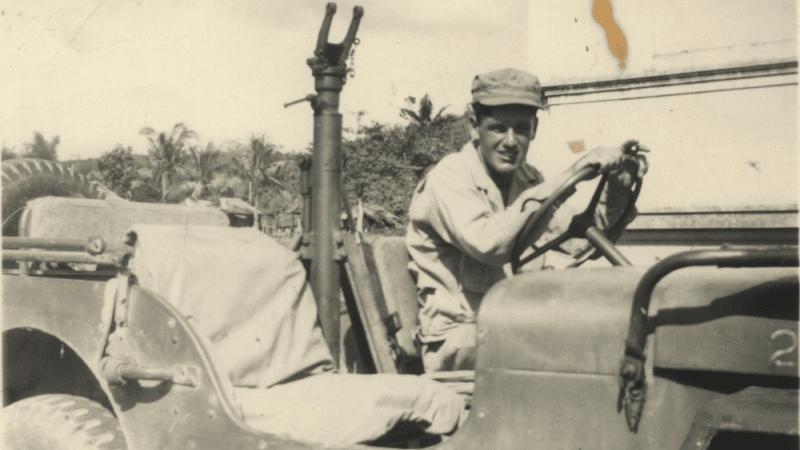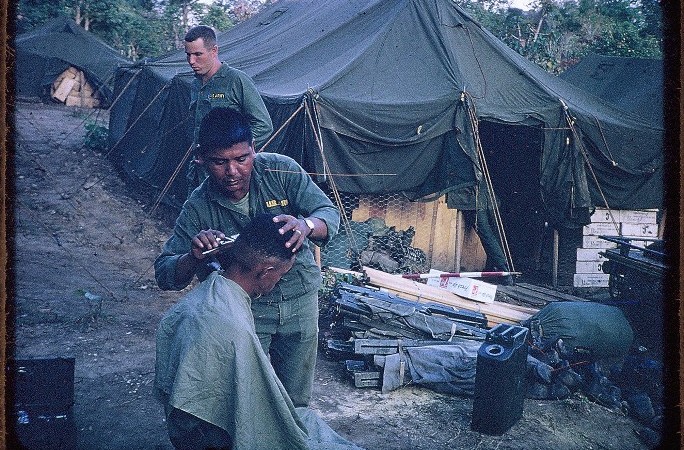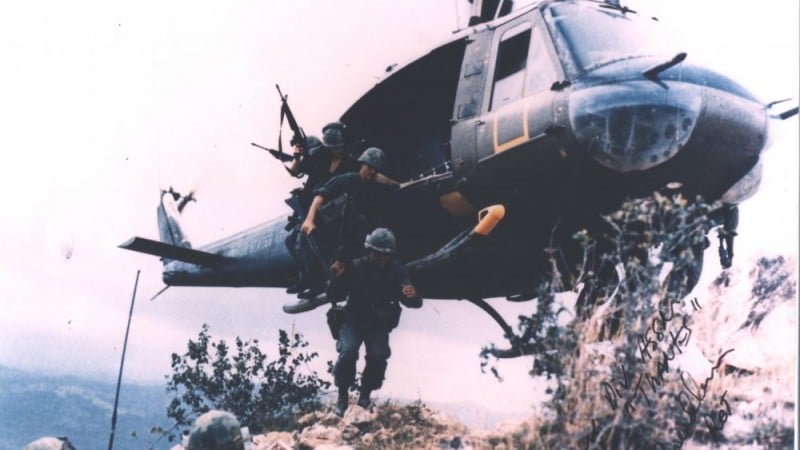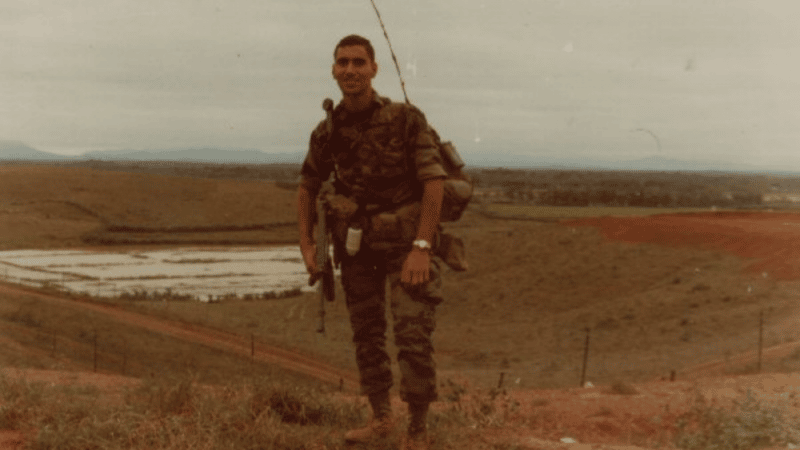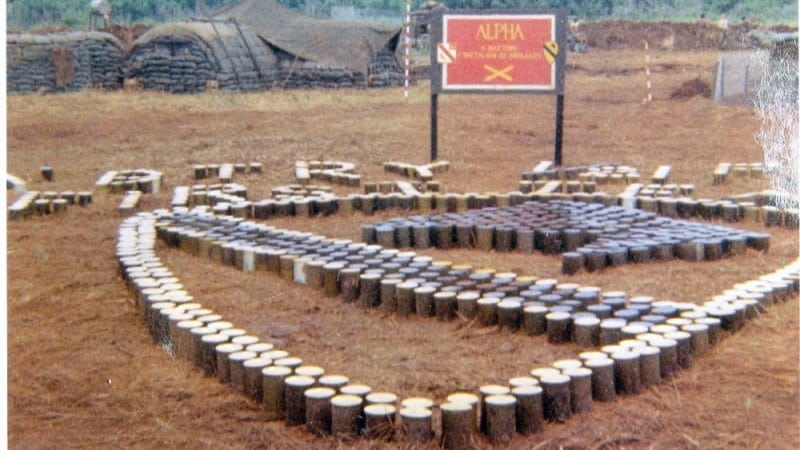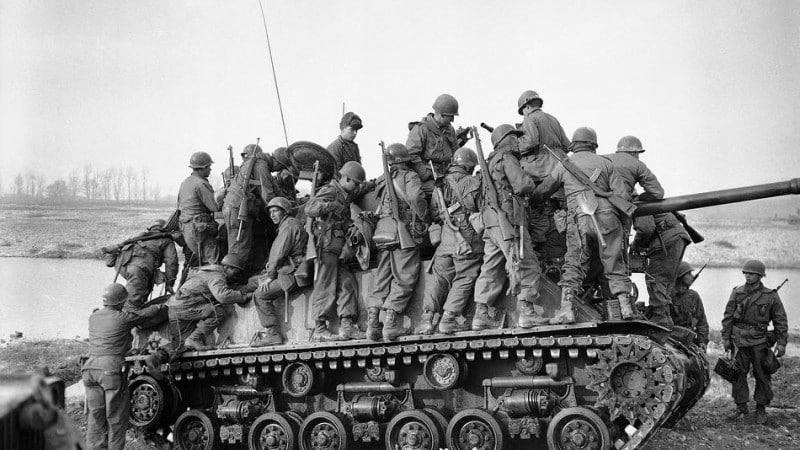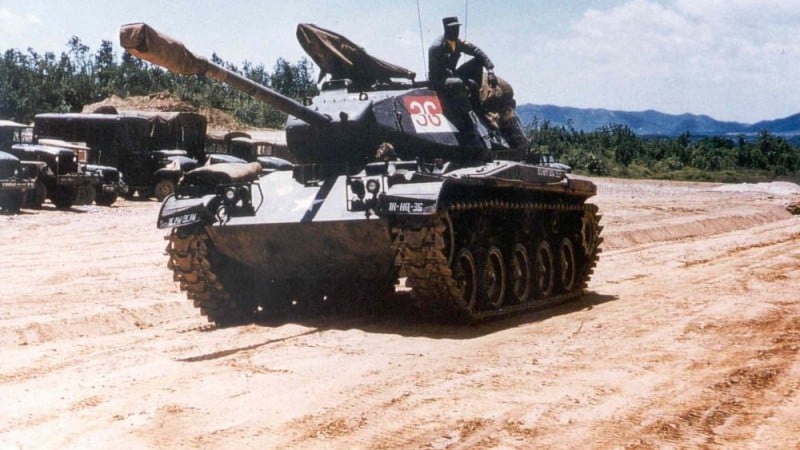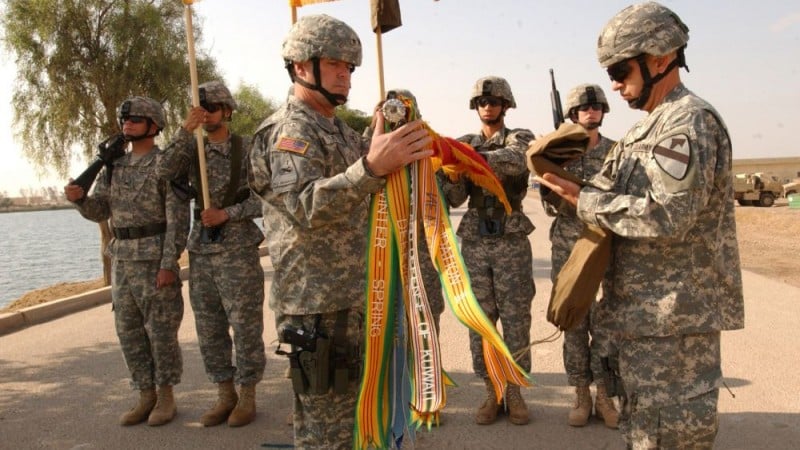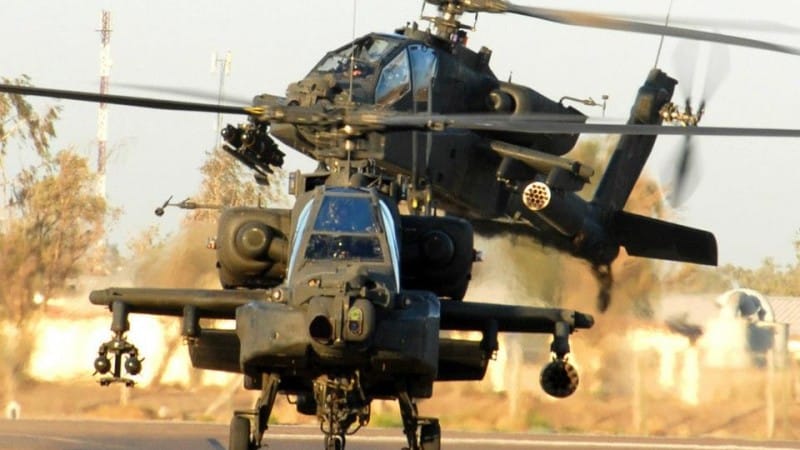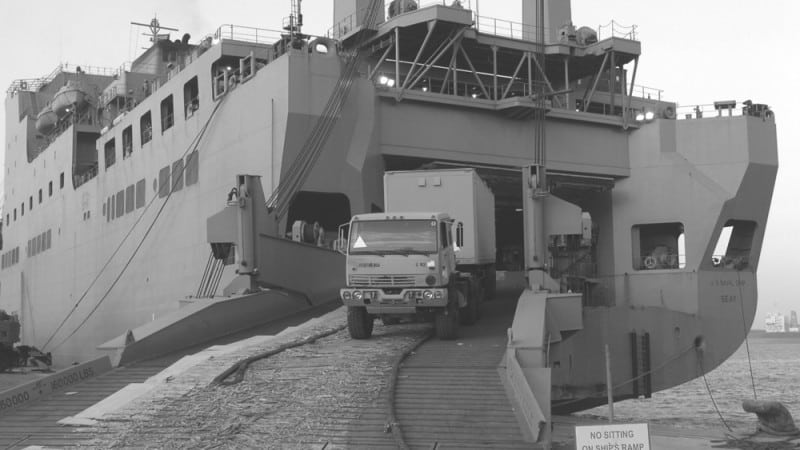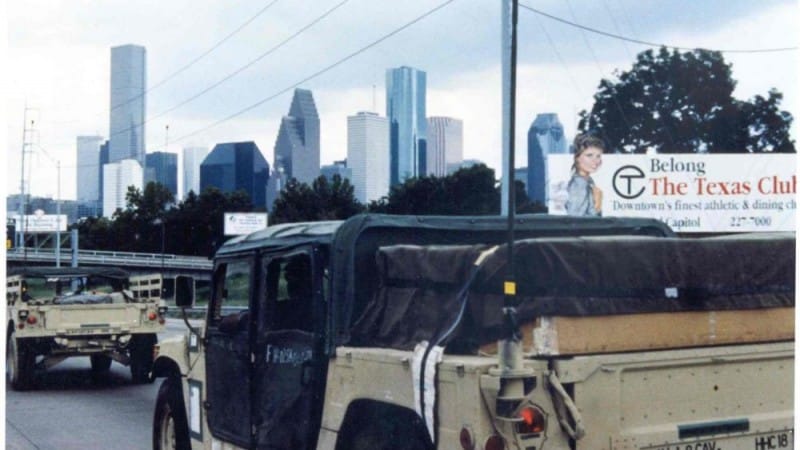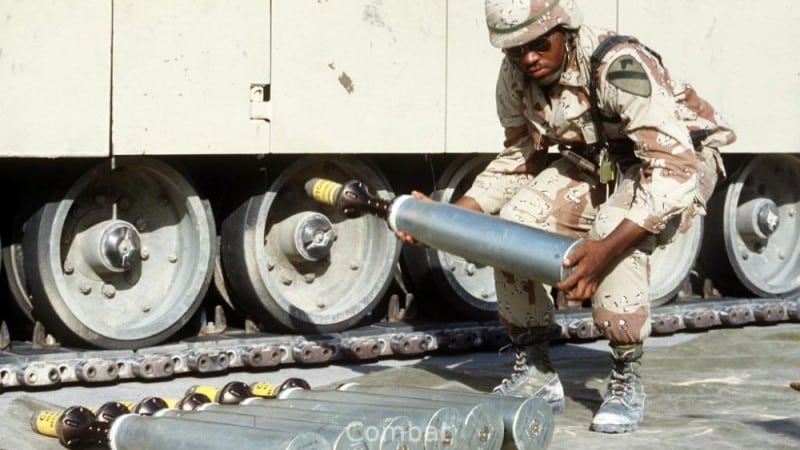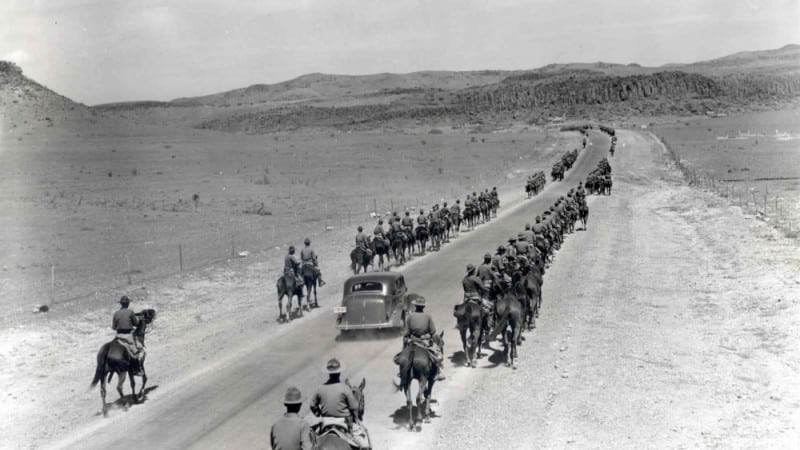8th Engineer Battalion
“Trojan Horse”
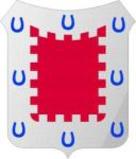
The 8th Engineer Battalion enjoys the unusual distinction of having its inception in a foreign country inasmuch as Company “A” was organized originally as Company “A”, 1st Battalion, Mounted Engineers at Vado de Fasiles, Chihuahua, Mexico on 1 August 1916. The forty nine men in the initial organization were transferred from Companies “E”, “G” and “H” of the “old” Second Battalion of Engineers. On 6 September 1916, the first inspection of the new organization was conducted by General Pershing at Twin Windmills, Mexico.
The use of motor trucks to supply the Mexican Expedition had made the necessity of good roads a vital priority. The new organization devoted its services to the solution of this problem. By October, the pressure of road work had decreased and all men who had any riding experience were removed from road work and assigned to training. On 2 December 1916, the Company was ordered to Dublin, (Mexico) for extensive training.
On 20 March 1917, Company “A” was assigned to the 1st Cavalry Division (Provisional) at Camp Stewart, Texas then under the command of General Eben Swift. On 21 May 1917, Companies “B” and “C” organized at Camp Stewart, Texas.
On 29 July 1917, the units were reorganized and redesignated as the 8th Engineer Battalion (Mounted) and on 27 November 1917, was assigned to the 15th Cavalry Division.
On 12 May 1918, the Battalion was relieved from assignment to the 15th Cavalry Division and on 27 July 1921 was assigned to the 1st Cavalry Division.
When the 1st Cavalry Division was organized on 13 September 1921, at Fort Bliss, Texas, recognition of the changing ways of combat engagement resulted in the 8th Engineer Battalion (Mounted) being assigned as an integral element of the division. On 11 May 1927, the Battalion left Fort Bliss by rail for Fort McIntosh, Texas for a permanent change of station. In 1930, the Battalion was reorganized from three lettered companies to three lettered troops, one mounted, two motorized and a Headquarters and Service Troop, Motorized and the designation was hanged from Battalion to Eighth Engineer Squadron.
In 1936, the Squadron participated in the maneuvers of the 1st Cavalry Division which was held at Marfa, Texas. It also took part in the Proposed Infantry Division Tests at Camp Bullis, Texas and in 1938, participated again in the 1st cavalry Division Maneuvers at Balmorhea, Texas. With the European war on the horizon, maneuvers accelerated. In 1939 the Squadron maneuvered at Camp Bullis, Texas and with the 1st Cavalry Division at Balmorhea, Texas. In August 1940, the Squadron returned to Fort McIntosh and took part in the Louisiana maneuvers in May and August. On 6 February 1941, the Squadron rejoined the 1st Cavalry Division at Fort Bliss, Texas for a permanent change of station.
World War II
The advent of new technology to warfare and the size of the American Army presented the Engineers with unprecedented challenges. While the mobility of the 1st Cavalry Division enables it to operate independently while in battle, it must have combat engineers for any major movement. In division missions, involving reconnaissance, counter-reconnaissance, delaying action or security, barrier tactics and passage of obstacles play a major part. Engineers not only supported the other combat arms — often fighting as infantry — but also built the camps, supply facilities, and transportation systems needed to sustain the fighting organization.
In February 1943, the entire 1st Cavalry Division was alerted for an overseas assignment as a dismounted unit. On 15 March 1943, further recognition of the role entrusted to the Engineer Squadron was given when it was reorganized and redesignated as the 8th Engineer Combat Squadron. On May 28 1943, the newly designated unit was deployed for overseas service on the U.S. Army Transport, “Maui” for duty in the South Pacific Theater.
Three weeks later, the Combat Squadron arrived at Brisbane and began a fifteen mile trip to their new temporary home, Camp Strathpine, Queensland, Australia. The division received six months of intense combat jungle warfare training at Camp Strathpine in the wilds of scenic Queensland and amphibious training at nearby Moreton Bay. In January 1944 the division was ordered to leave Australia and sail to Oro Bay, New Guinea. After a period of staging in New Guinea, it was time for the 1st Cavalry Division to receive their first baptism of fire.
On 27 February, Task Force “Brewer”, consisting of 1,026 Troopers, embarked from Cape Sudest, Oro Bay, New Guinea under the command of Brigadier General William C. Chase. Their destination was a remote, Japanese occupied island of the Admiralties, Los Negros, where they were to make a reconnaissance of force and if feasible, capture Momote Airdrome and secure a beachhead for the reinforcements that would follow.
Just after 0800 hours on 29 February, the 1st Cavalry Troopers climbed down the nets of the APD’s and into the LCM’s and LCPR’s, the flat bottomed landing craft of the Navy. The task force, including “A” Troop, 8th Engineer Combat Squadron, landed at Hayane Harbor and took the Japanese by surprise.
On 18 May 1944, the Admiralty Islands campaign officially ended. Japanese casualties stood at 3,317 killed. The losses of the 1st Cavalry Division included 290 dead, 977 wounded and 4 missing in action. Training, discipline, determination and ingenuity had won over suicidal attacks. The First Cavalry Troopers were now seasoned Veterans.
The next action for the 1st Cavalry Division was on the Philippines Island of Leyte. On Columbus Day, 12 October 1944, the 1st Cavalry Division sailed away from its hard earned base in the Admiralties for the Leyte invasion, Operation King II. On October 20, the invasion force must have appeared awesome to the waiting Japanese as it swept toward the eastern shores of Leyte. The division fought tirelessly against Japanese fortifications. With the last of the strongholds of Leyte eliminated, the division moved on to Luzon, the main island of the Philippines. Leyte had been the biggest campaign of the Pacific war, but the record was about to be shattered by the invasion of Luzon.
On 26 January, conveys were formed and departed for the Lingayan Gulf, Luzon Island, the Philippines. Landing without incident on 27 January, the division assembled in an area near Guimba and prepared for operations in the south and southwest areas. One of the First Team’s most noted feats was accomplished during the fighting for Luzon. General MacArthur issued an order “Get to Manila!”. The resulting mission, and the participating units, was dubbed a “flying column” by General Mudge. The rescue mission, lead by Brig. General William C. Chase, was divided into three “serials”. The first serial included the 8th Engineers. On 3 February 1945, lead elements of the rescue column crossed the city limits of Manila at 1835 hours, covering the 100 miles of rough terrain in approximately 66 hours. The first of many “Firsts” was recorded in history; “First in Manila”
On 13 August 1945, the 1st Cavalry Division was alerted that they were selected to accompany General Douglas MacArthur to Tokyo and would be part of the 8th Army in the occupation of Japan. On 2 September the long convey of ships steered into Yokohama Harbor and past the battleship Missouri where General MacArthur would later receive the Japanese surrender party. The First Team was given the honor of leading the Allied Occupational Army into Tokyo. At noon on 5 September 1945, a reconnaissance team headed by Colonel Charles A. Sheldon, the Chief of Staff of the 1st Cavalry Division, entered Tokyo. This embarkment was the first official movement of American personnel into the capital of the mighty Japanese Empire.
At 0800 hours on 8 September, a history making convoy left Hara-Machida with Tokyo as their destination. Headed by Major General William C. Chase, commanding general of the 1st Cavalry Division, the party included a Veteran from each troop of the division. Passing through Hachioji, Fuchu and Chofu, the Cavalry halted briefly at the Tokyo City Limits. General Chase stepped across the line thereby putting the American Occupational Army officially in Tokyo and adding another “First” to its name; “First in Tokyo”
The first mission of the division was to assume control of the city. On 16 September, the 1st Cavalry Division was given responsibility for occupying the entire city of Tokyo and the adjacent parts of Tokyo and Saitama Prefectures. On 25 February, the 8th Engineers were assigned a permanent station at Camp Drake near Tokyo.
1946 was welcomed as a new dawning of peace for the 1st Cavalry Division. The days of privation, hardship, suffering and death were over for the first time since 7 December 1940. The year found the 1st Cavalry Division in control of Tokyo and vicinity, the capital of the war-built Japanese Empire. On 1 March, the 1st Cavalry Division was given the occupational responsibility of seven prefectures of Japan, in addition to the four occupied during the previous months.
The 1st Cavalry Division began 1947 with the continuation of its occupation of the heart and nerve center of the Japanese Empire. Although there was no change in occupational policy, there had been vast changes among the Troopers themselves. The combat Veterans of the division had been replaced by new arrivals from the states. Their time was spent in receiving advanced training, guard duty, patrolling and specialist assignments over the next two years. In 1950, an increased training was emphasized to improve the ever-increasing combat effectiveness of the division which was soon to be tested.
The Korean War
It happened before dawn on 25 June 1950. Less than 5 years after the terrible devastations of World War II, a new war broke out from a distant land whose name means “Morning Calm”. On the same day in June, the 8th Engineer Combat Battalion, located at Camp Drake, Asaka, Japan was performing normal Engineer Functions in support of the 1st Cavalry Division. “D” Company and the 3rd Platoon of “A” Company was located at Camp McGill, Japan were undergoing amphibious assault training. Training and preparations for overseas movement intensified. By 2 July, “D” Company and the 3rd Platoon, “A” Company had returned to Camp Drake. “B” and “D” Company were dispatched to Camp McGill to be trained as shore party. In final preparations, the 8th Engineers received their assignments to the Regimental Combat teams, “A” Company with the 5th Cavalry Regiment, “B” Company with the 7th Cavalry regiment and C” Company to the 8th Cavalry Regiment. On 18 July, the 1st Cavalry Division was ordered to Korea.
Initially scheduled to make an amphibious landing at Inchon, it was redirected to the southeastern coast of Korea at Pohang-dong a port 80 miles north of Pusan. On 18 July, the 8th Cavalry Regiment, accompanied by “C” Company was the first to land followed by the 5th Cavalry with “B” Company. The North Koreans were 25 miles away when elements of the 1st Cavalry Division swept ashore to successfully carry out the first amphibious landing of the Korean War. Its initial mission was to establish the Pusan Perimeter. The landing of the 7th Cavalry and “B” Company was delayed by typhoon. On 21 July, the Battalion, minus the second and third lifts, moved by motor convey to Paegak-tong. By 22 July, all regiments were deployed in battle positions; in itself a remarkable logistical achievement in the face of Typhoon Helene that pounded the Korean coastline.
The 1st Battalion, 8th Cavalry Regiment, located forward of Yongdong, southwest of fallen Taejon, was the first to have contact with the enemy. In the early morning hours of 23 July, the North Koreans had launched a heavy artillery attack against the 2nd Battalion and concurrently the North Korean Infantry launched an attack against the 1st Battalion. Subsequent analysis of the orders of the 8th Army which established the locations of the 1st and 2nd Battalions, 8th Cavalry set the stage for the encirclement of the 2nd. Otherwise known as – military ineptitude! The 1st Battalion, 5th Cavalry moved south from Yongdong to assist the encircled 2nd Battalion of the 8th.
The rugged, mountainous terrain of Korea and the lack of developed transportation and communications systems, created significant challenges for the 8th Engineer Battalion. Most of the initial Engineer work involved demolition of bridges and important facilities in an attempt to delay the North Korean advance to the south. In the Pusan Perimeter, the invasion point of the 1st Cavalry Division, the 8th Engineering Battalion not only worked on standard defensive and construction projects, but also manned the front lines when the enemy threatened to penetrate the perimeter.
The 1st Cavalry Division was assigned to defend a 35 mile sector along the Naktong River, extending from three miles north of Waegwan south to the area defended by the 24th Infantry Division. On 9 August, the North Koreans hurled five full divisions and parts of a sixth against the Naktong defenders. On 14 August, a second powerful punch was delivered to the 7th Cavalry Regiment, but timely assistance from the 8th Engineers, 16th Reconnaissance and artillery caused the termination of the attack. To reduce the attack options of the North Koreans around Waegwan, the dominating terrain linking Waegwan and Tabu-dong, just 12 miles north of Taegu, would have to be reduced. Task Force Allen, composed of two provisional infantry battalions, was organized. The 8th Combat Engineer Battalion was pressed into service as infantry. “D” Company was given the mission to secure the “Walled City of Kasan”. The Engineers fought their way to their destination and held it.
It was in this battle, repelling counterattacks, that PFC Melvin L. Brown, Company “D” distinguished himself by conspicuous gallantry and intrepidity above and beyond the call of duty in action against the enemy. While his platoon was securing Hill 755 (the Walled City), the enemy, using heavy automatic weapons and small arms, counterattacked. Taking a position on a 50-foot-high wall he delivered heavy rifle fire on the enemy. His ammunition was soon expended and although wounded, he remained at his post and threw his few grenades into the attackers causing many casualties. When his supply of grenades was exhausted his comrades from nearby foxholes tossed others to him and he left his position, braving a hail of fire, to retrieve and throw them at the enemy. The attackers continued to assault his position and PFC Brown weaponless, drew his entrenching tool from his pack and calmly waited until they 1 by 1 peered over the wall, delivering each a crushing blow upon the head. Knocking 10 or 12 enemy from the wall, his daring action so inspired his platoon that they repelled the attack and held their position. PFC Brown’s extraordinary heroism, gallantry, and intrepidity reflect the highest credit upon himself and was in keeping with the honored traditions of the military service.
The turning point in this bloody battle came on 15 September 1950, when MacArthur unleashed his plan, Operation Chromite, an amphibious landing at Inchon, far behind the North Korean lines. In spite of the many negative operational reasons given by critics of the plan, the Inchon landing was an immediate success allowing the 1st Cavalry Division to break out of the perimeter and start fighting north. The 8th Engineers made a substantial contribution to the crossing of the 38th Parallel by sweeping for mines and repairing a bombed out railroad bridge, located on the Yesong River, for troop crossing on 09 October 1950. The Troopers of the 1st Cavalry crashed into Pyongyang, capturing the capital city of North Korea on 19 October 1950. This event marked the third “First” for the division – First in Pyongyang.
In late October 1950, orders came from I Corps to saddle up the rest of the division and move north. The Korean War seemed to be nearing a conclusion. The North Korean forces were being squeezed into a shrinking perimeter along the Yalu and the borders of Red China and Manchuria. Company “A” was kept busy constructing POW stockades at Pyongyang. By now, more than 135,000 Red troops had been captured and the North Korean Army was nearly destroyed.
On 25 October 1950, the Korean War took a grim new turn. The sudden intervention of Communist Chinese forces dashed hopes of a quick end to the war. In the morning of 1 November, patrols from the 1st and 2nd Battalions, 8th Cavalry along with “C” Company, 8th Engineers, clashed with Soldiers clearly identified as Red Chinese. The battle at Unsan left a deadly toll on the 8th Cavalry Regiment and members of “C” Company. The blackest month of the campaign ended bitterly for the 8th Engineer Combat Battalion, as it was withdrawing rapidly for the second time in November. By late December, the true extent of the enemy buildup had become clear. There were at least 20 Red Chinese divisions poised for a drive on Seoul. Now there was almost a million and a half Chinese and North Korean troops on the Korean peninsula.
The year ended unexpectedly quiet. The First Team defenders readied their weapons, shored up their defenses and waited in the bitter cold. This time there was no surprise when the Chinese artillery began pounding the UN lines in the first few minutes of 1951. The units forward of the 38th Parallel were hit by the Chinese crossing the frozen Imjin River. Ignoring heavy losses, the Chinese crawled through mine fields and barbed wire. The United Nations Forces abandoned Seoul and fell back to the Han River. With several breakthroughs reported along the front, “A” Company received orders to destroy the rail and highway bridges previously primed for demolition. The Chinese drive lost its momentum when it crossed the Han and a lull fell over the front. By 23 January, the period of withdrawing to previously prepared positions appeared to be at an end, as “A”, “B” and “C” Companies reattached to their Regimental Combat Teams, began to move north to gain contact with the enemy.
On 25 January 1951, the First Team, joined by the revitalized 3rd Battalion, 8th Cavalry rebounding from its tragedy at Unsan, moved back into action. The movement began as a reconnaissance in force to locate and assess the size of the Red Army, believed to be at least 174,000. The Eight Army moved slowly and methodically, ridge by ridge, phase line by phase line, wiping out each pocket of resistance before moving farther North. The advance covered 2 miles a day, despite heavy blinding snowstorms and subzero temperatures.
On 14 February, heavy fighting erupted around an objective known as Hill 578, which was finally was taken by the 7th Cavalry after overcoming stiff Chinese resistance. During this action General MacArthur paid a welcome visit to the 1st Team. The 1st Cavalry slowly advanced though snow and later, when it became warm, through torrential rains. The Red Army was slowly; but firmly, being pushed back. On 14 March, the 3rd Battalion, 8th Cavalry had crossed the Hangchon River and on the 15th, Seoul was recaptured by elements of the 8th Army. New objectives were established to keep the Chinese from rebuilding and resupplying their forces and to advance to the “Kansas Line”, which roughly followed the 38th Parallel and the winding Imjin River.
On 4 April, the 1st Cavalry Division crossed the 38th Parallel for the second time of the war. “A” Company moved forward to establish a bivouac area in Chunchon. Resisting stubbornly, the enemy fell back before the push of the 8th Army. Enemy resistance increased, particularly in the vital Chorwon-Kumwha area. On 22 April, 21 Chinese and 9 North Korean divisions slammed into Line Kansas. Their main objective was to recapture Seoul. The 1st Cavalry joined in the defense line and the bitter battle to keep the Reds out of the South Korean Capital. Stopped at Seoul, on 15 May, the Chinese attempted a go around maneuver in the dark. The 8th Army pushed them back to the Kansas Line and later the First Team moved deeper into North Korea, reaching the base of the “Iron Triangle”, a major enemy supply area encompassing three small towns.
From 9 June to 27 November, the 1st Cavalry took on various rolls in the summer-fall campaign of the United Nations. On 18 July, a year after it had entered the war, the 1st Cavalry Division was assigned to a reserve status. This type of duty did not last for long. On the nights of 21 and 23 September, the 2nd and 3rd Battalions, 7th Cavalry repulsed waves of Red Chinese with hand to hand fighting. But harder work followed when Operation “Commando”, a mission to push the Chinese out of their winter defense positions south of the Yokkok River, was launched. As the operation progressed, the 8th Engineers cleared or destroyed all of the many mine fields which were laid by the enemy in their retreat.
On 3 October, the 1st Team moved out from Line Wyoming and immediately into Chinese fire. For the next two days; hills were taken, lost and retaken. On the third day, the Chinese lines began to break in front of the 7th Cavalry. On 5 October, the 8th Cavalry recaptured Hill 418, a flanking hill on which the northern end of Line Jamestown was anchored. On 10 – 11 October, the Chinese counterattacked; twice, unsuccessfully against the 7th Cavalry. Two days later, the 8th Cavalry took the central pivot of the line, Hill 272. The southern end of Line Jamestown, along with a hill called “Old Baldy”, eventually fell to the determined Troopers. The Troopers did not know it, but Line Jamestown would be their last major combat of the Korean War.
On 24 November 1951, in preparation for movement to Japan, members of the 120th Engineer Combat Battalion arrived at the 8th Engineer Battalion Headquarters to receive all T/O & E property of the 8th Engineers. By December 1951, the division, after 549 days of continuous fighting, began rotation back to Hokkaido, Japan. The First Team had performed tough duties with honor, pride and valor with distinction.
On 5 December, “A” Company departed Korea with the 5th Cavalry Regiment and arrived at Camp Chitose, Area I on the 11th. By 23 December, all units had arrived in Hokkadio and were assigned the following stations: “B” Company – Camp Crawford, “H/S”, “C” and “D” – Camp Chitose, Area II. The division controlled a huge training area of 155,000 acres. The mission of the division was to defend the Island of Hokkaido and to maintain maximum combat readiness. Essentially, the war for the 1st Cavalry was ended, however it would be more than a year before other units could leave Korea. The 8th Engineer Battalion would return to Korea in 1952 and 1953 to engage in engineering construction tasks.
In September 1954, the Japanese assumed responsibility for defending Hokkaido and the First Team returned to the main Island of Honshu. For the next three years the division guarded the northern sections of Honshu until a treaty was signed by the governments of Japan and the United States in 1957. This accord signaled the removal of all U.S. ground forces from Japan’s main islands.
On 20 August 1957, the First Cavalry Division, guarding the northern sections of Honshu, Japan was reduced to zero strength and transferred to Korea (minus equipment). On 23 September 1957, General Order 89 announced the redesignation of the 24th Infantry Division as the 1st Cavalry Division and ordered a reorganization of the Division under the “pentomic” concept. In ceremonies held on 15 October, the colors of the 24th Division were retired and the colors of the 1st Cavalry Division were passed to the Commanding General of the old 24th Division, Major General Ralph W. Zwicker. “The First Team” had returned, standing ready to defend Korea against Communist aggression.
The 1st Cavalry Division took over the facilities of the former 24th Infantry Division who were stationed at a Headquarters Compound located in the western defense corridor located at Bong il Chong in the Paju City area. Previous tenants, the 1st Marine Division, had relocated the summer villa and converted the rice patties, at the entrance to the valley, into an attractive lake. By the time the 1st Cavalry Division arrived, they were able to be billeted in permanent Quonset huts which had been constructed during a major program to improve the troops living conditions.
The redesignated and reorganized 1st Cavalry was assigned the mission of patrolling the “Freedom’s Frontier” (DMZ). In addition to their assigned duties of patrol along the southern border of the DMZ, training remained a number one priority for the Troopers and unit commanders. In January 1958, the largest training exercise in Korea since the end of hostilities, Operation Snowflake, was conducted. This exercise was followed by Operation Saber in May and Operation Horsefly in August.
In 1959, the 8th Engineer Battalion made several modifications to their Headquarters installation and filled in the lake, at the entrance, to create a parade ground. It was named “Brown Field” in honor of PFC Melvin L. Brown, Company “D”, 8th Engineer Battalion, who was posthumously awarded the Medal of Honor for heroic actions on 4 September 1950. After being designated a Headquarters compound for many years, the installation was redesignated “Camp Howze” on 25 March, 1960 in honor of Major General Robert L. Howze, Medal of Honor recipient and the 1st commander of the 1st Cavalry Division from 1921-25.
The Vietnam War
The 1st Cavalry remained headquartered at Camp Howze until 1 July 1965. At that time the 1st Cavalry Division was redesignated the 2nd Infantry Division. The 1st Cavalry Division went home, but only long enough to be reorganized and be prepared for a new mission. On 3 July 1965, in Doughboy Stadium at Fort Benning, Georgia the colors of the 11th Air Assault Division (Test) were cased and retired. As the band played the rousing strains of Garryowen, the colors of the 1st Cavalry Division were moved onto the field. As part of the reorganization, the 127th Engineering Battalion, Support Command, 11th Air Assault Division (Test) was redesignated as the 8th Engineering Battalion, Support Command, 1st Cavalry Division (Airmobile).
Within 90 days of becoming the Army’s first air mobile division, the First Team was back in combat as the first fully committed division of the Vietnam War. An advance party of “C” Company, 8th Engineer Battalion, on board C-130s, arrived at Nha Trang on 16 August. Bt 21 August, the remainder of the advance party arrived. They joined with advance liaison forces and established a temporary base camp near An Khe, 36 miles inland from the coastal city of Qui Nhon. On 12 September, the remainder of the battalion, on board the USNS Darby arrived at Qui Nhon.
For the 8th Engineers, Vietnam was another conflict fought in a distant underdeveloped region. With the commitment of ground troops in 1965, Engineers had the dual responsibilities of supporting combat operations and of constructing support facilities for the Army, its sister services, and allied nations.
One of the first assignments given to the 8th Engineer Battalion was the construction of a signal complex on the top of a nearby mountain. Access to the construction site was made possible by the use of CH-54, Flying Cranes to move the heavy earth moving equipment. All this was done while construction and upgrading of Camp Radcliff continued. On 10 October 1965, the 8th Engineers engaged in their first tactical operation in “Operation Shiny Bayonet”, the First Team had initiated a first brigade-size airmobile action against the enemy. The air assault task force consisted of the 1st and 2nd Battalions, 7th Cavalry, 1st Squadron, 9th Cavalry, 1st Battalion, 12th Cavalry and the 1st Battalion, 21st Artillery. Rather than standing and fighting, the Viet Cong chose to disperse and slip away.
In late January 1966, the Battalion launched an extensive airfield construction program which resulted in new airfields and access roads at Hammond, Plai Mrong, Oasis, Polai Kleng, Dong Tre and Plateau Gi. In 1967, the construction effort of expanding the number of fire bases and airfields in II Corps was among the many missions for the battalion. In October 1968, when notified of the move to III Corps, the 8th Engineers picked up the equivalent of a medium sized town and moved to the other end of South Vietnam and constructed the first ten LZs. Within days the division was conducting normal combat operations without a hitch.
During 1969, the 8th Engineers were innovative in the development of new concepts of combat support. Most of the work performed by the battalions was carried out in remote areas inaccessible by normal wheeled vehicles. The men, equipment and supplies were airlifted over impassable terrain. In one day, the engineers could establish a fire support base which could operate independently by the use of aerial resupply, enabling the division to operate in areas previously enemy sanctuaries.
On 1 May 1970, the First Team was “First into Cambodia” hitting what was previously a Communist sanctuary. President Nixon has given the go-ahead for the surprise mission. The 8th Engineer Battalion was given the responsibility for building the “stepping stone” firebases and landing zones leading into the “Fish Hook” region of the border. The 1st Cavalry Division, occupying the towns of Mimot and Snoul, forced the enemy out of their fortified base camps, scattering them and depriving them of much needed supplies and ammunition. On 8 May, the Troopers of the 2nd Brigade found an enemy munitions base that they dubbed “Rock Island East”. The engineers were called upon to help evacuate the caches of munitions and food. Ending on 30 June, the mission to Cambodia far exceeded all expectations and proved to be one of the most successful operations of the First Team. The Troopers and the ARVN Soldiers had found uncommonly large quantities of ammunition, including 1.5 millions rounds for small arms, 200,000 antiaircraft rounds and 143,000 rockets, mortar rounds and recoilless rifle rounds. The sweeps turned up 300 trucks, a Porsche sports car and a plush Mercedes-Benz sedan.
Although 26 March 1971 officially marked the end of duties in Vietnam for the 1st Cavalry Division, President Nixon’s program of “Vietnamization” required the continued presence of a strong U.S. fighting force. The 2nd Battalion of the 5th Regiment, 1st Battalion of the 7th Regiment, 2nd Battalion of the 8th Regiment and 1st Battalion of the 12th Regiment along with specialized support units as “F” Troop, 9th Cavalry and Delta Company, 229th Assault Helicopter Battalion and “C” Company, 8th Engineer Battalion helped establish the 3rd Brigade headquarters at Bien Hoa. Its primary mission was to interdict enemy infiltration and supply routes in War Zone D.
On 5 May 1971, the 8th Engineer Battalion, Less “C” Company returned to the United States, stationed at Fort Hood, Texas and was redesignated 8th Engineer Battalion (TRICAP). In August 1971, “C” Company was redesignated the 501st Engineer Company and remained in Vietnam with the 3rd Brigade until their return to the States.
By 31 March 1972, only 96,000 U.S. troops were involved in the Vietnam combat operations. In mid June 1972, the stand-down ceremony for the 3rd Brigade was held in Bein Hoa and the colors were returned to the United States. The last Trooper left from Tan Son Nhut on 21 June, completing the division recall which had started on 5 May 1971. With the 3rd Brigade completing their withdrawal, the 1st Cavalry had been the first army division to go to Vietnam and the last to leave. “Firsts” had become the trademark of the First Team.
On 22 March 1975, the battalion reorganized as an armored engineer battalion as part of the division restructure study and participated as the engineer element of the test. In June 1980, “D” Company was brought to zero strength as part of the 3rd Brigade and supporting slice draw down.
Persian Gulf War, Southwest Asia
On 10 August 1990, the 8th Engineering Battalion was put on the alert for deployment to Southwest Asia as a result of the invasion of Kuwait by Iraq. Two months later the Division, including the Tiger Brigade, 2nd Armored Division and “A” Company, 17th Engineering Battalion was dispatched to the Arabian Desert. In anticipation of an Iraqi invasion, defenses were established along the Iraqi and Kuwaiti borders. The engineers prepared for battle by constructing bases, paving roads and building the Pegasus firing test range.
In a battle against time and weather, the engineers, operating their own equipment as well as abandoned civilian bulldozers and backhoes, dug alongside the infantry. In 48 hours, an anti-tank ditch ringed the defenders of El Qaysumah Airport for 13 Kilometers. Bright yellow caterpillar tractors on the battlefield were a jarring sight, but none complained.
The efforts of the Engineer Battalion were key to operations in preparation of the ground war. These operations allowed the Allies to pass west and into Iraqi commencing the ground war. The battalion held in place, then moved deep into Iraq aiding in the swift defeat of the Iraqi armed forces. In April 1991, the battalion brought all its Soldiers safely home to Fort Hood, Texas.
Fort Hood
In May 1992, the battalion was increased to five companies by reactivation “D” Company from the former “A” Company, 17th Engineer Battalion. The tactical significance of the Engineering organizations of the 1st Cavalry Division was recognized on 28 April 1992, with the provisional activation of the Engineer Brigade, 1st Cavalry Division and the Headquarters and Headquarters Detachment at Fort Hood, Texas. The Brigade was formed by reorganizing the 8th Engineer Battalion in July 1992, moving the 20th Engineer Battalion from Fort Campbell, Kentucky, reorganizing it from a wheeled corps to a mechanized divisional battalion in June 1992 and by activating the 91st Engineer Battalion from a zero balance in October 1992.
The War on Terror and Beyond
On 11 September 2001, terrorists attacked the World Trade Center and Pentagon and created a period known as the “War on Terror”. The battalion deployed to Iraq in support of Operation Iraqi Freedom II, conducting combat operations in support of the 1st Cavalry Division in the Al Wahda District of Baghdad.
Returning to Fort Hood the Army began the reorganization of the 1s Cavalry Division to the Modular configuration. This resulted in the inactivation of the Engineer Brigade and all of the Engineer battalions in the Division. The 8th Engineer Battalion was inactivated at Fort Hood on 24 May 2005.
The 8th Engineer Battalion was then reactivated on 16 August 2007 and reorganized as a modular formation within the 36th Engineer Brigade on 16 October 2007. By 12 June 2008, the Battalion stood up, trained, and deployed the 937th Clearance Company, the first in the Army, 87th Sapper Company and the Battalion Headquarters in support of OIF 08-10.
In December 2010, the 8th Engineer Battalion deployed to Khandahar Province, Afghanistan in support of Operation Enduring Freedom until December 2011. The battalion returned to Afghanistan providing support to RC-East in 2013.
After returning from Afghanistan the battalion was briefly inactivated. The battalion was redesignated as the 8th Brigade Engineer Battalion (BEB) and assigned to the 2nd Brigade Combat Team, 1st Cavalry Division at Fort Hood, Texas on 17 June 2014. As a part of the 2nd BCT of the 1st Cavalry Division, the Trojan Horse Battalion deployed to Korea for a nine-month deployment marking the return of the battalion to duty in the Land of the Morning Calm in June 2015.
The Trojan Horse Battalion is the largest battalion sized unit in the 2nd BCT and not only has engineer companies but also has the Signal Company, Military Intelligence Company, and Unmanned Aerial unit. The 8th Brigade Engineer Battalion continues to train and prepare for war at Fort Hood, Texas.
Compiled from History of the 8th Engineer Battalion on the web page of William H. Boudreau, Historian of the 1st Cavalry Division Association and the 8th Engineer Battalion, 36th Engineer Brigade web page.
Lineage and Honors of the 2nd Battalion, 19th Field Artillery
Lineage of the 2nd Battalion, 19th Field Artillery
Constituted 1 July 1916 in the Regular Army as Battery B, 19th Field Artillery. Organized 1 June 1917 at Camp Wilson, Texas (19th Field) Artillery assigned 12 December 1917 to the 5th Division (latter redesignated as the 5th Infantry Division). Inactivated 6 September 1921 at Camp Bragg, North Carolina. Activated 3 December 1934 at Fort Benjamin Harrison, Indiana.
Reorganized and redesignated 1 October 1940 as Battery B, 19th Field Artillery Battalion. Inactivated 20 September 1946 at Camp Campbell, Kentucky. Activated 15 July 1947 at Fort Jackson, South Carolina. Activated 1 March 1951 at Indiantown Gap Military Reservation, Pennsylvania. Inactivated 1 September at Indiantown Gap Military Reservation, Pennsylvania. Activated 25 May 1954 at Augsburg, Germany. Inactivated 1 June 1957 at Fort Ord, California and relieved from assignment to the 5th Infantry Division.
Redesignated 15 October 1957 as Headquarters and Headquarters Battery, 2nd Howitzer Battalion, 19th Artillery, assigned to the 1st Cavalry Division, and activated in Korea (organic elements concurrently constituted and activated). Redesignated 1 September 1963 as the 2nd Battalion, 19th Artillery. Inactivated 2 April 1971 at Fort Lewis, Washington. Redesignated 1 September 1971 as the 2nd Battalion, 19th Field Artillery. Activated 20 April 1974 at Fort Hood, Texas. Inactivated 30 March 1979 at Fort Hood, Texas.
Honors of the 2nd Battalion, 19th Field Artillery
Campaign Participation Credit |
| World War I St. Mihiel Lorraine 1918World War II Normandy Northern France Rhineland Ardennes-Alsace Central EuropeVietnam War Defense Counteroffensive Counteroffensive, Phase II Counteroffensive, Phase III Tet Counteroffensive Counteroffensive, Phase IV Counteroffensive, Phase V Counteroffensive, Phase VI Tet 69/Counteroffensive Summer-Fall 1969 Winter-Spring 1970 Sanctuary Counteroffensive Counteroffensive, Phase VII |
Decorations |
| Presidential Unit Citation — 23 Oct – 26 Nov 65, DAGO 40, 67
Valorous Unit Award — 1 May – 29 Jun 70, DAGO 43, 72 Republic of Vietnam Gallantry Cross w/Palm — 9 Aug 65 – 19 May 69, DAGO 59, 69; May 69 – Feb 70, DAGO 11,73, amended DAGO 42, 72; 21 Feb 70 – 28 Feb 71, DAGO 42, 72 Republic of Vietnam Civil Actions Honor Medal, FC — 1 Jan 69 – 1 Feb 70, DAGO 42, 72 Valorous Unit Award — 6 May 69, DAGO 39, 70 Artillery Liaison Section Battery A Battery B Detachment of thirteen (13) personnel of the 2d Battalion |
